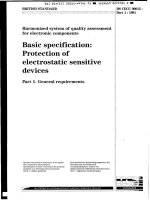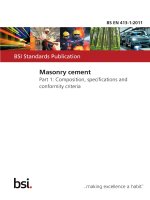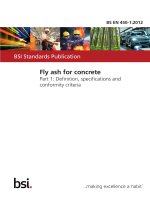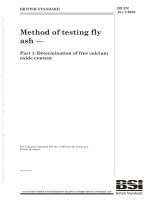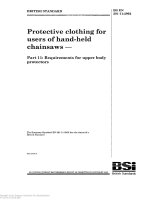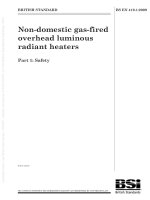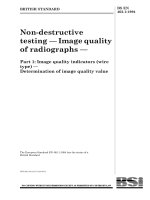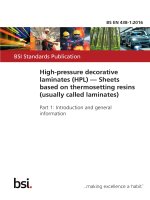Bsi bs en 61993 1 2001 scan
Bạn đang xem bản rút gọn của tài liệu. Xem và tải ngay bản đầy đủ của tài liệu tại đây (2.09 MB, 47 trang )
BS EN
BRITISH STANDARD
6 1993-1:2O01
IEC
O
61993-1:1999
Maritime navigation
and
radiocornmunication
equipment and
systemsO
Part 1: Shipbourne automatic
transponder system installation using
VHF digital selective calling (DSC)
techniques - Operational and
performance requirements, methods of
testing and required test results
The European Standard EN 61993-1:2001has the status of a
British Standard
ICs 47.020.70
NO COPYING WITHOUT BSI PERMISSION EXCEPT AS PERMITTED BY COPYRIGHT LAW
--```,,,-`-`,,`,,`,`,,`---
Copyright European Committee for Electrotechnical Standardization
Provided by IHS under license with CENELEC
No reproduction or networking permitted without license from IHS
Not for Resale
BS EN 61993-1~2001
National foreword
This British Standard is the official English language version of EN 619931:1999. It is identical with IEC 61993-1:1999.
The UK participation in its preparation was entrusted to Technical Committee
EPLI80, Maritime navigation and radiocommuniaction equipment systems,
which has the responsibility to:
-
aid enquirers to understand the text;
-
present to the responsible internationallEuropean committee any
enquiries on the interpretation, or proposals for change, and keep the
UK interests informed;
-
monitor related international and European developments and
promulgate them in the UK.
A list of organizations represented on this committee can be obtained on
request to its secretary.
From 1January 1997, all IEC publications have the number 60000 added to
the old number. For instance, IEC 27-1 has been renumbered as IEC 60027-1.
For a period of time during the change over from one numbering system to the
other, publications may contain identifiers from both systems.
Cross-references
The British Standards which implement these international or European
publications may be found in the BSI Standards Catalogue under the section
entitled “International Standards Correspondence Index”, or by using the
“Find” facility of the BSI Standards Electronic Catalogue.
A British Standard does not purport to include all the necessary provisions of
a contract. Users of British Standards are responsible for their correct
application.
Compliance with a British Standard does n o t of itself confer immunity
from legal obligations.
This British Standard, having
been prepared under the
direction of the
Electrotechnical Sector Board,
was published under the
authority of the Standards
Committee and comes into
effect on 15 August 2001
Summary of pages
This document comprises a front cover, an inside front cover, the EN title page,
pages 2 to 44, an inside back cover and a back cover.
The BSI copyright date displayed in this document indicates when the
document was last issued.
Amendments issued since publication
Amd. No.
Date
Comments
O BSI 08-2001
ISBN O 580 35075 4
--```,,,-`-`,,`,,`,`,,`---
Copyright European Committee for Electrotechnical Standardization
Provided by IHS under license with CENELEC
No reproduction or networking permitted without license from IHS
Not for Resale
EN 61993-1
EUROPEAN STANDARD
NORME EUROPEENNE
O
EUROPÄISCHE NORM
August 1999
ICs 47.020.70
English version
Maritime navigation and radiocommunication equipment and systems
Part 1: Shipborne automatic transponder system installation using
VHF digital selective calling (DSC) techniques
Operational and performance requirements,
methods of testing and required test results
(IEC 61993-1:1999)
O
Navigations- und
--```,,,-`-`,,`,,`,`,,`---
Matériels et systèmes de navigation et de
radiocommunication maritimes
Partie 1: Installation de systèmes de
répondeur automatique de bord de
navires utilisant des techniques d'appel
sélectif numérique en ondes métriques
Exigences d'exploitation et de
fonctionnement, méthodes d'essai et
résultats d'essai exigés
(CE1 61993-1 1999)
Funkkommunikationsgerate und -Systeme
für die Seeschiffahrt
Teil 1: Installationen für ein automatisches
Transpondersystem für Schiffe, das die
Technik des digitalen Selektivrufs (DSC)
auf UKW einsetzt Betriebs- und
Leistungsanforderungen, Prüfveríahren
und geforderte Prüfergebnisse
(IEC 6 1993-1 1999)
This European Standard was approved by CENELEC on 1999-08-01. CENELEC members are bound to
comply with the CENKENELEC Intemal Regulations which stipulate the conditions for giving this European
Standard the status of a national standard without any alteration.
Up-to-date lists and bibliographical references concerning such national standards may be obtained on
application to the Central Secretariat or to any CENELEC member.
This European Standard exists in three offcial versions (English, French, Geman). A version in any other
language made by translation under the responsibility of a CENELEC member into its own language and
notified to the Central Secretariat has the same status as the official versions.
CENELEC members are the national electrotechnical committees of Austria, Belgium, Czech Republic,
Denmark, Finland, France, Germany, Greece, Iceland, Ireland, Italy, Luxembourg, Netherlands, Norway,
Portugal, Spain, Sweden, Switzerland and United Kingdom.
CENELEC
European Committee for ElectrotechnicalStandardization
Comité Européen de Normalisation Electrotechnique
Europäisches Komitee für Elektrotechnische Normung
-
Central Secretariat: rue de Stassart 35, B 1050 Brussels
@ 1999 CENELEC -
All rights of exploitation in any form and by any means reserved mildwide for CENELEC members.
Ref. No. EN 61993-1:1999 E
Copyright European Committee for Electrotechnical Standardization
Provided by IHS under license with CENELEC
No reproduction or networking permitted without license from IHS
Not for Resale
EN 61993-1~1999
Foreword
The text of document 80/212/FDIS, future edition 1 of IEC 61993-1, prepared by IEC TC 80,
Maritime navigation and radiocommunication equipment and systems, was submitted to the IECCENELEC parallel vote and was approved by CENELEC as EN 61993-1 on 1999-08-01.
The following dates were fixed:
- latest date by which the EN has to be implemented
at national level by publication of an identical
national standard or by endorsement
(dop) 2000-05-01
- latest date by which the national standards conflicting
(dûw) 2002-08-01
with the EN have to be withdrawn
Annexes designated "normative" are part of the body of the standard.
Annexes designated "informative" are given for information only.
In this standard, annexes B and ZA are normative and annexes A and C are informative.
Annex ZA has been added by CENELEC.
Endorsement notice
The text of the International Standard IEC 61993-1:1999 was approved by CENELEC as a
European Standard without any modification.
--```,,,-`-`,,`,,`,`,,`---
2
Copyright European Committee for Electrotechnical Standardization
Provided by IHS under license with CENELEC
No reproduction or networking permitted without license from IHS
Not for Resale
EN 61993-1:1999
CONTENTS
Page
INTRODUCTION ....................................................................................................................
5
Clause
1
Scope ..............................................................................................................................
6
2
Normative references .......................................................................................................
7
3
Definitions and abbreviations ............................................................................................
8
4
3.1 Definitions .............................................................................................................. 8
8
3.2 Abbreviations ..........................................................................................................
General requirements .......................................................................................................
9
5
4.1 General ..................................................................................................................
4.2 Composition ............................................................................................................
4.3 Design and construction ..........................................................................................
4.4 Controls and indicators ..........................................................................................
4.5 interfacing .............................................................................................................
4.6 Permissible warming-up period ..............................................................................
Performance requirements ..............................................................................................
9
9
10
10
10
10
7
5.1 General ................................................................................................................. 10
5.2 Compatibility .
.
.
.
.
.
.
.
.
.
.
.
.
.
.
.
.
.
.
.
.
.
.
.
.
.
.
.
.
.
.
.
.
.
.
.
.
.
.
.
.
.
.
.
.
.
.
.
.
.
.
.
.
.
.
.
.
.
.
.
.
.
.
.
.
.
.
.
.
.
.
.
.
.
.
.
.
.
.
.
.
.
.
.
.
.
.
.
.
.
.
.
.
.
.
.
.
.
.
.
.
.
.
.
.
.
.
.
1
5.3 Identification ......................................................................................................
...11
Operational requirements ................................................................................................
11
6.1 Ship-shore identification .........................................................................................
11
12
6.2 Ship-ship identification ...........................................................................................
Technical requirements ................................................................................................... 13
8
7.1
7.2
7.3
7.4
7.5
7.6
7.7
7.8
7.9
7.1 O
Test
6
a
8.1
8.2
8.3
8.4
8.5
8.6
8.7
8.8
8.9
Channel sensing ....................................................................................................
Class of emission and modulation characteristics ...................................................
Frequency bands and channels ..............................................................................
Switching time .......................................................................................................
Safety precautions .................................................................................................
Transmitter ............................................................................................................
Receiver ................................................................................................................
Antenna system .....................................................................................................
Power supply .........................................................................................................
System DSC facility ................................................................................................
conditions ................................................................................................................
--```,,,-`-`,,`,,`,`,,`---
O
9
13
14
13
13
13
14
14
14
15
15
15
General .................................................................................................................
15
Unspecified tests ................................................................................................... 16
Test power source ................................................................................................. 16
Normal test conditions ........................................................................................... 16
17
Extreme test conditions ..........................................................................................
17
Procedures for tests at extreme temperatures ........................................................
18
Test signals ...........................................................................................................
Measurement of bit error rate (BER) ....................................................................... 18
Measurement uncertainty and interpretation of the measurement results ................19
3
0 BSI 07-2001
Copyright European Committee for Electrotechnical Standardization
Provided by IHS under license with CENELEC
No reproduction or networking permitted without license from IHS
Not for Resale
EN 61993-1:1999
9
Environmental tests .........................................................................................................
19
9.1 Introduction ............................................................................................................
9.2 Temperature tests ..................................................................................................
9.3 Vibration ................................................................................................................
9.4 Corrosion ...............................................................................................................
9.5 Rain .......................................................................................................................
10 Performance tests ...........................................................................................................
1O .1 General .................................................................................................................
10.2 Compatibility ..........................................................................................................
10.3 Identification ..........................................................................................................
11 Operational tests .............................................................................................................
11.1 Ship-shore identification .........................................................................................
11.2 Ship-ship identification ...........................................................................................
12 Technical tests ................................................................................................................
12.1 Sensing capability ..................................................................................................
12.2 Switching time .......................................................................................................
13 Transmitter tests .............................................................................................................
19
19
20
20
20
20
13.1 Frequency error .....................................................................................................
13.2 Carrier power .........................................................................................................
13.3 Frequency deviation ...............................................................................................
13.4 Sensitivity of the modulator ....................................................................................
13.5 Modulation index ....................................................................................................
13.6 Adjacent channel power .........................................................................................
13.7 Conducted spurious emissions conveyed to the antenna ........................................
13.8 Transient frequency behaviour of the transmitter ....................................................
14 Receiver tests .................................................................................................................
23
23
23
24
25
25
26
26
28
14.1 Calling sensitivity ...................................................................................................
14.2 Dynamic range .......................................................................................................
14.3 Co-channel rejection ..............................................................................................
14.4 Adjacent channel selectivity ...................................................................................
14.5 Blocking immunity ..................................................................................................
14.6 Intermodulation response .......................................................................................
14.7 Conducted spurious emissions into the antenna .....................................................
15 Other tests ......................................................................................................................
28
28
29
29
30
30
31
31
15.1 Antenna system .....................................................................................................
15.2 Power supply .........................................................................................................
15.3 Compass safe distance ..........................................................................................
16 Safety precautions ..........................................................................................................
17 EMC.emissions ...............................................................................................................
31
30
30
32
18 EMC immunity .................................................................................................................
32
Annex A (informative) Relationship between bit error rate (BER) input and symbol error
rate (SER) output .............................................................................................................................................
35
Annex 8 (normative) Power measuring receiver specification..............................................................................
20
21
21
21
21
21
22
22
22
23
32
39
C (informative) Description of the operation of the system ........................................................................
41
Annex ZA (normative) Normative references to international publications with their corresponding European
publications .....................................................................................................................................................
43
Annex
Figures
1 Test Set-up for measuring transient frequency behaviour .................................................................................
33
2 Storage oscilloscope view t i . t2 and t3 ...........................................................................................................
34
--```,,,-`-`,,`,,`,`,,`---
Copyright European Committee for Electrotechnical Standardization
Provided by IHS under license with CENELEC
No reproduction or networking permitted without license from IHS
Not for Resale
O BSI 07-2001
INTRODUCTION
In 1995 the IMO instigated work on the development of performance standards for a shipborne
automatic identification system (AIS) using VHF digital selective calling (DSC) techniques.
These performance standards were developed into a draft resolution which was expected to be
adopted by the IMO Maritime Safety Committee. However, there were objections to this on the
grounds that some requirements for AIS were not met by the draft resolution.
The outcome has been that IMO has now developed further performance standards for a
“Universal AIS” as a resolution which was adopted by the IMO Maritime Safety Committee in
May 1998 as MSC. 74(69) annex 3.
During this period, some countries have gone ahead and implemented operational systems
based upon the original IMO draft performance standards for AIS. There is therefore a need for
a technical testing standard for such equipment.
At their plenary meeting in September 1997, technical committee 80 came to the following
decisions:
-
a draft technical standard which had been prepared on the basis of the original IMO
performance standards would go ahead with the reference 61993-1, but would not directly
refer to any IMO resolution for AIS;
- work would commence at the earliest opportunity on preparing a technical standard for a
“Universal AIS” based rigorously upon the IMO resolution MSC.74(69) and a new‘
recommendation ITU-R M.1371. This standard would have the reference 61993-2.
-
--```,,,-`-`,,`,,`,`,,`---
5
O BSI 07-2001
Copyright European Committee for Electrotechnical Standardization
Provided by IHS under license with CENELEC
No reproduction or networking permitted without license from IHS
Not for Resale
EN 61993-1:1999
MARITIME NAVIGAT ION AN D RADI OC OM M UN I CATION EQUI PM ENT
AND SYSTEMS Part 1: Shipborne automatic transponder system installation
using VHF digital selective calling (DSC) techniques
Operational and performance requirements,
methods of testing and required test results
-
Scope
This part of IEC 61993 specifies the performance requirements, technical characteristics,
operational requirements, methods of testing and required test results for shipborne automatic
transponder system installations using VHF digital selective calling (DSC) techniques and is
associated with IEC 60945. When a requirement in this standard is different from IEC 60945,
the requirement in this standard shall take precedence.
The shipborne transponder installation is intended to assist in the efficient operation of shipreporting systems and vessel traffic services (VTS) by enabling operators to identify, poll and
automatically locate and track ships when they are approaching, entering and sailing within the
limits of a ship-reporting system.
The system may also be used for the identification of ships by a ship and ships by aircraft. A
description of the system is given in annex C.
This standard
- incorporates the technical characteristics included in ITU-R Recommendation M.825 for
transponder systems using DSC and the technical characteristics included in ITU-R
Recommendation M.489 for VHF radiotelephone equipment;
- incorporates the technical characteristics of DSC equipment and the operational
procedures for its use contained in Recommendations ITU-R M.493 and ITU-R M.541;
- incorporates applicable parts of the performance standards of IMO Resolution A.803 for
shipborne VHF radio installations;
- takes account of IMO Resolution A.694 for general requirements; and
-
conforms with the International Telecommunication Union (ITU) Radio Regulations where
applicable.
This standard for a transponder system is not intended to meet the requirements for a
universal automatic identification system (AIS), as detailed in IMO Resolution MSC.74(69)
annex 3.
NOTE - All text in this standard whose meaning complies with that in the normative references, namely IMO
Resolution A.803(19) and ITU-R Recommendations M.825, M.489, M.493 and M.541 is followed by a reference to
the source (number of IMO Resolution or ITU-R Recommendation and paragraph number) in brackets.
6
Copyright European Committee for Electrotechnical Standardization
Provided by IHS under license with CENELEC
No reproduction or networking permitted without license from IHS
O BSI 07-2001
Not for Resale
--```,,,-`-`,,`,,`,`,,`---
1
EN 61993-1:1999
2
Normative references
The following normative documents contain provisions which, through reference in this text,
constitute provisions of this part of IEC 61993. For dated references, subsequent amendments
to, or revisions of, any of these publications do not apply. However parties to agreements
based on this part of IEC 61993 are encouraged to investigate the possibility of applying the
most recent editions of the normative documents indicated below. For undated references, the
latest edition of the normative documents referred to applies. Members of IEC and I S 0
maintain registers of currently valid International Standards.
IEC 60945:1996, Maritime navigation and radiocommunication equipment and systems
General requirements, methods of testing and required fest results
-
IEC 61097-3:1994, Global maritime distress and safety system (GMDSS) - Part 3: Digital
selective calling (DSC) equipment - Operational and performance requirements, methods of
testing and required testing results
0
IEC 61097-7:1996, Global maritime distress and safety system (GMDSS) - Part 7: Shipborne
VHF radiotelephone transmitter and receiver - Operational and performance requirements,
methods of testing and required test results
IEC 61 162 (all parts), Maritime navigation and radiocommunicaation equipment and systems
Digital interfaces
-
IMO International Convention for Safety of Life at Sea (SOLAS) 1974, as amended
IMO Resolution A.694: 1991, General requirements for shipborne radio equipment forming part
of the global maritime distress and safety system (GMDSS) and for electronic navigational aids
IMO Resolution A.803:1995, Performance standards for shipborne VHF radio installations
capable of voice communication and digital selective calling
IMO MSC.74(69):1998, annex 3 - Performance standards for an Universal shipborne automatic
identification system (AIS)
ITU Radio Regulations:l997
0
ITU-R Recommendation M.489-2: 1995, Technical characteristics of VHF radiotelephone
equipment operating in the maritime mobile service in channels spaced by 25 kHz
--```,,,-`-`,,`,,`,`,,`---
ITU-R Recommendation M.493-9:1997, Digital selective-calling system for use in the maritime
mobile service
ITU-R Recommendation M.541-8:1997, Operational procedures for the use of digital selective
calling (DSC) equipment in the maritime mobile service
ITU-R Recommendation M.825-2: 1997, Characteristics of a transponder system using digital
selective-calling techniques for use with vessel traffic services and ship-to-ship identification
ITU-R Recommendation M.1371:1998, Technical characteristics for a universal shipborne
automatic identification system using time division multiple access in the VHF maritime mobile
band
ITU-T Recommendation, V. 11:1996, Electrical characteristics for balanced double-current
interchange circuits operating at data signalling rates up to 70 Mbiüs
O BSI 07-2001
Copyright European Committee for Electrotechnical Standardization
Provided by IHS under license with CENELEC
No reproduction or networking permitted without license from IHS
7
Not for Resale
EN 61993-1~1999
ITU-T Recommendation V.24: 1996, List of definitions for interchange circuits between data
terminal equipment (DTE) and data circuit-terminating equipment ( D E )
ITU-T Recommendation V.28: 1993, Electrical characteristics for unbalanced double-current
interchange circuits
3
Definitions and abbreviations
3.1
Definitions
For the purpose of this standard, the following definitions apply.
3.1.1
status
navigational status of the ship as expressed by the second digit 1-7 of the two-digit symbols to
indicate other ships (table 3 of Recommendation ITU-R M.825)
3.1.2
performance check
quick test under normal test conditions of the transmitter frequency error to 13.1, the transmitter
output power to 13.2 (high power only) and the receiver calling sensitivity to 14.1, with standard
test signal number 2 applied at a level of + I 2 dBpV. For results required, see 9.1.2
3.1.3
sensor
device which provides information to the system such as position, course and speed
3.2
Abbreviations
--```,,,-`-`,,`,,`,`,,`---
BER
Bit error rate
DCE
Data circuit-terminating equipment
DSC
Digital selective calling
DTE
Data terminal equipment
ECDIS
Electronic chart display and information system
EMC
Electromagnetic compatibility
e.m.f.
Electromotive force
EUT
Equipment under test
GMDSS
Global maritime distress and safety system
GPS
Global positioning system
IEC
International Electrotechnical Commission
IMO
International Maritime Organization
ITU
International Telecommunication Union
ITU-R
ITU Radiocommunication sector (formerly CCIR)
ITU-T
ITU Standardization sector (formerly CCITT)
MMSI
Maritime mobile service identity
p.t.t.
press-to-transmit
r.m.s.
root-mean-square
SOLAS
Safety of Life at Sea (International convention for the)
Copyright European Committee for Electrotechnical Standardization
Provided by IHS under license with CENELEC
No reproduction or networking permitted without license from IHS
O BSI 07-2001
Not for Resale
EN 61993-1:1999
UTC
Universal time co-ordinated
VHF
Very high frequency
VTS
Vessel traffic services
4
4.1
General requirements
General
4.1.1 Requirements contained in clause 4 cannot be verified by repeatable measurements.
The manufacturer shall declare that compliance to these requirements is achieved and shall
provide relevant documentation. The declaration(s), documentation and, when necessary, the
equipment shall be checked.
4.1.2 The system shall have a high level of availability, shall enable operators to obtain
information from the ship automatically, whenever practicable, and require a minimum of
involvement of ship's personnel, thus reducing the burden of communication on board ships.
4.1.3 The system installation, in addition to meeting the requirements of the Radio
Regulations, the relevant ITU-R recommendations 1) and the general requirements set out in
IMO A.694, as detailed in IEC 60945, shall comply with the following requirements and the
requirements contained in clauses 5 and 6 of this standard.
4.2
Composition
4.2.1 The installation shall comprise of at least
--```,,,-`-`,,`,,`,`,,`---
0
- x
- a transmitterlreceiver including antenna;
- a digital selective calling facility;
- a dedicated DSC watchkeeping facility to maintain watch on the designated calling
frequency except during periods when the installation is required to operate on working
channels in accordance with instructions from shore-based stations;
- an electronic position-fixing system capable of providing horizontal accuracy of 1O0 m (95 YO);
- means to input and receive information;
- means for the automatic change to a working channel on request of the shore-based
interrogating station.
4.2.2 The manufacturer shall declare the composition of the equipment and also the relevant
category to IEC 60945 for each unit.
4.3
Design and construction
4.3.1 The installation shall operate continuously while underway or at anchor. The equipment
shall be designed for continuous operation.
4.3.2 The system functions may be performed by separate units appropriately interconnected
or be integrated with a radio transmitter andlor receiver.
NOTE - "Integrated" means that the systgm function is physically integrated into a radio transmitter andlor receiver
that the system functions can only be tested by RF measurements.
SO
1) Recommendations ITU-R M.825, M.493, M.541
0 BSI 07-2001
Copyright European Committee for Electrotechnical Standardization
Provided by IHS under license with CENELEC
No reproduction or networking permitted without license from IHS
9
Not for Resale
EN 61993-1:1999
4.4
Controls and indicators
4.4.1
-
The installation shall be provided with visual indication to show
the equipment is switched on;
- the transponder function is disabled;
- the equipment is being interrogated; and
- the equipment is transmitting;
- loss of external data.
4.5
Interfacing
4.5.1 To enable a user display of information for example at a radar or ECDIS, the system
shall be provided with a serial interface conforming to IEC 61 162.
4.5.2 Interfaces for external sensors providing data for the system shall conform to
IEC 61 162.
4.5.3 As a minimum, the system shall be capable of operating with the sentences GGA, GLL,
VBW, VTG, DSI, and DSR of IEC 61 162.
4.5.4 When the installation comprises an external watch receiver, input terminals for AF, or
alternatively DSC signals at logic level, the interfaces shall be as follows.
4.5.4.1 AF terminals for DSC signals shall have input and output impedance of 600 0,
symmetrical and free of earth, with a closed-circuit level adjustable to 0,775 V (r.m.s.) f 10 dB
for connection to AF terminals of external radio equipment.
--```,,,-`-`,,`,,`,`,,`---
4.5.4.2 Alternatively, terminals for DSC signals at logic levels shall have the electrical
characteristics compatible with Recommendation ITU-T V.ll. The B-state shall be the logic "O",
and the Y-state shall be the logic "1".
4.5.4.3 Additionally, terminals for DSC signals may be provided with characteristics as
defined in ITU-T Recommendations V.24 and V.28.
4.6
Permissible warming-up period
The installation shall be operational within 1 min of switching on.
NOTE - Sensors used with the system shall meet the requirements of their individual product standards (for
example, IEC 61 108-1 for G P S which permits 30 min to operation when there is no valid almanac data available).
5
5.1
Performance requirements
General
5.1.1 The system shall provide for calls of the category safety using DSC. (82516.1)
5.1.2 Means shall be provided to automatically record all periods when the installation is nonfunctioning. It shall not be possible for the user to alter any information recorded by this device.
5.1.3 The last 10 times when the equipment is non-functioning for more than 15 min shall be
recorded in UTC time and duration in a non-volatile memory. Means shall be provided to
recover this data.
10
Copyright European Committee for Electrotechnical Standardization
Provided by IHS under license with CENELEC
No reproduction or networking permitted without license from IHS
O BSI 07-2001
Not for Resale
EN 61993-1:1999
5.1.4 The installation shall be capable of receiving and processing all calls transmitted by an
interrogating station.
5.1.5 The installation may not be required to process DSC type calls which are not AIS calls;
however, such calls shall not affect correct system operation.
5.1.6 The installation shall be capable of operating on single-frequency channels or on singleor two-frequency channels.
5.1.7 The installation shall be capable of automatically transmitting a response. An automatic
response shall be transmitted to any interrogation containing one or more of the symbols 101,
102, 103, 108, 109, 111, 112 and 116.
5.1.8 When an automatic response is required but the requested information is not available,
the relevant symbol shall be followed by the symbol 126. Symbol 126 shall also be transmitted
for null-fields in the DSI sentence of IEC 61162.
5.2
Compatibility
5.2.1 Where the installation is combined with other VHF installations, in accordance with ITU
Radio Regulations Article 61, interrogating transmissions shall have priority over all
communications other than those of a higher priority as prescribed in that article. Facilities
shall be provided to disable the installation for communications of higher priority.
5.2.3 In a combined installation, the system is permitted to operate the transmitter for the
duration of a DSC call for system purposes provided that after the transmission the VHF
installation returns automatically to its previous settings. Interrogations containing symbol
number 101 to table 4 of Recommendation ITU-R M.825 shall cause the system to respond on
the VHF channel indicated for any following symbols in the interrogating message. The system
shall then return to channel 70 operation. If symbol number 101 is followed by symbol number
102, all subsequent position reports shall be made on the indicated VHF channel. These
position reports will not normally be acknowledged by the originator of the request.
5.3
--```,,,-`-`,,`,,`,`,,`---
5.2.2 Such facilities shall be adequately protected from inadvertent operation and the times of
disabling recorded in conformity with 5.1.2. Continuous watch on the designated calling
frequency (Channel 70) shall be maintained irrespective of the frequency being used for
communications by the installation.
Identification
For the purpose of ship identification, the appropriate MMSI shall be used.
6
6.1
Operational requirements
Ship-shore identification
6.1.1 To enable shore-based authorities to identify the ship, the following information, which it
shall not be possible for the user to change, shall be programmed in a secure manner into the
installation:
- ship’s MMSI;
-
ship’s name (symbol number 115 to table 4 of ITU-R M.825);
- ship’s length (symbol number 124 to table 4 of ITU-R M.825); and
O BSI 07-2001
Copyright European Committee for Electrotechnical Standardization
Provided by IHS under license with CENELEC
No reproduction or networking permitted without license from IHS
11
Not for Resale
I
EN 61993-1~1999
-
type of ship (symbols numbers 50-55,58, 59, 69, 79, 89 and 99 to table 3 of ITU-R M.825).
6.1.2 The following information shall be programmed into the installation automatically, either
from integral equipment or from suitable sensor sources:
- ship's position (symbol number 100 to table 4 of ITU-R M.825);
- course of ship over ground (symbol number 119 to table 4 of ITU-R M.825); and
-
speed of ship over ground (symbol number 120 to table 4 of Recommendation ITU-R
M.825).
NOTE -Where external sensors are used, these shall be protected against de-activation by the user.
6.1.3 Facilities shall be provided to enable the user to readily programme additional
information into the installation in accordance with the relevant ITU-R Recommendation 2).
6.1.4
The additional information shall include at least
- draught (symbol number 123 to table 4 of ITU-R M.825);
-
next port of call (symbol number 121 to table 4 of ITU-R M.825);
- destination (symbol number 114 to table 4 of ITU-R M.825);
-
entering or leaving VTS (symbols numbers 105 and 107 to table 4 of ITU-R M.825); and
- status (applicable second digit 1-7 of symbols to indicate other ships to table 3 of ITU-R M.825).
6.1.5 Where facilities to programme additional information are not integral to the system they
shall be provided to the installation.via a.serial interface complying to IEC 61162.
6.2
Shi p-s hip identif¡cation
6.2.1 For ship-to-ship identification purposes, the installation shall not allow the user to
transmit interrogation messages addressed to a group of ships other than to a numerical
geographic address no larger than 0,5 square nautical miles in area.
6.2.2 To enhance identification, the installation shall provide facilities to use other forms of
address so as to add either course or ship type to the geographic address, in accordance with
ITU-R M.825, in any interrogation message.
6.2.3 The installation shall permit the user to obtain, in addition to the ship's MMSI, the
following information from addressed ships for identification purposes:
- position (symbol number 100 to table 4 of ITU-R M.825);
- course over ground (symbol number 119 to table 4 of ITU-R M.825);
-
speed (symbol number 120 to table 4 of ITU-R M.825); and
- ship's name and call sign (symbol number 115 to table 4 of ¡TU-R M.825). (8.3)
6.2.4 It shall not be possible for the user to obtain additional information from other ships by
use of the installation.
6.2.5 Means shall be provided to prevent more than three call attempts from the system in
any period of 15 min.
2) Recommendation ITU-R M.825
--```,,,-`-`,,`,,`,`,,`---
12
Copyright European Committee for Electrotechnical Standardization
Provided by IHS under license with CENELEC
No reproduction or networking permitted without license from IHS
O BSI 07-2001
Not for Resale
EN 61993-1:1999
6.2.6 Ship-to-ship interrogation shall be at low transmitting power, in the range of between
0,l W a n d 1 W.
7
Technical requirements
7.1
Channel sensing
7.1.1 Provision shall be made for sensing the VHF channel 70 used for digital selective calling
purposes to determine the presence of a signal, for automatically preventing the transmission
of a transponder call until the channel is free.
--```,,,-`-`,,`,,`,`,,`---
0
7.2
Class of emission and modulation characteristics
7.2.1
Class of emission shall comply with appendix 19 of the Radio Regulations. (80313.4)
7.2.2 The class of emission shall be phase modulation G2B for DSC signalling. (48911.1.1
and 1.I
.3)
7.3
Frequency bands and channels
7.3.1 The equipment shall be capable of operating as follows:
- in the band 156,3 MHz to 156,875 MHz on single-frequency channels as specified in
appendix S I 8 to the Radio Regulations including at least 156,525 MHz (channel 70); .and
- in the band 156,025 MHz to 157,425 MHz for transmitting and the band 160,625 MHz to
162,025 MHz for receiving on two-frequency channels as specified in appendix S I 8 to the
Radio Regulations. (80313.2)
7.3.2 Where duplex or semi-duplex systems are in use, the performance of the equipment
.4)
shall continue to comply with the requirements of this standard. (489/1 .I
7.3.3 The equipment shall be designed to operate satisfactorily with a channel separation of
25 kHz in accordance with appendix S I 8 of the Radio Regulations.
7.4
Switching time
7.4.1 Change of frequency shall be capable of being made as rapidly as possible, but in any
event within 5 s. (80314.1. I )
7.4.2 The time taken to switch from the transmit to the receive conditions, and vice versa,
shall not exceed 0,3 s. (80314.1.2)
7.5
Safety precautions
7.5.1 The installation, when operating, shall not be damaged by the effects of open-circuited
or short-circuited antenna terminals.
7.5.2 The equipment shall not be able to transmit during channel switching operation.
(80314.1.7)
O
7.5.3 Operation of the transmitlreceive (p.t.t.) control shall not cause, unwanted emissions.
(80314.1.8)
0 BSI 07-2001
Copyright European Committee for Electrotechnical Standardization
Provided by IHS under license with CENELEC
No reproduction or networking permitted without license from IHS
13
Not for Resale
EN 61993-1:1999
7.6
Transmitter
7.6.1 The frequency tolerance for ship station transmitters shall not exceed 10 parts in 106.
(489/1.2.1) For practical reasons, the frequency error shall be within I1,5 kHz.
7.6.2
The transmitter output power shall be between 6 W and 25 W.
7.6.3 Provision shall be made for reducing the transmitter output power to a value of between
0,l W and 1 W. However, this reduction of the power is optional on channel 70. (803/7.2)
7.6.4 The frequency deviation shall not exceed 15 kHz. Deviation limiting circuits shall be so
employed that the maximum frequency deviation attainable shall be independent of the input
audio frequency. The frequency deviation corresponding to 1O0 % modulation shall approach
15 kHz as nearly as practicable. (48911.25)
7.6.5 Spurious emissions on discrete frequencies, when measured in an artificial antenna as
described in 8.7.5, shall be in accordance with the provisions of appendix S3 of the Radio
Regulations. (489/1.2.2)
The power of any conducted spurious emission on any discrete frequency shall not exceed
0,25 pW in the frequency range 9 kHz to 1 GHz and 1 pW in the frequency range 1 GHz to
2 GHz.
7.7
Receiver
7.7.1 With a DSC modulated input signal having a level of 1 pV e.m.f. to its associated VHF
receiver, the DSC transponder installation shall be capable of decoding the received message
with a maximum permissible output character error rate of 10-2. (See annex A for the rationale
for using BER measurements.)
7.7.2 The immunity to interference of the receiver shall be such that the wanted signal is not
seriously affected by unwanted signals.
7.7.3
The co-channel rejection ratio shall be between -8 dB and O dB.
7.7.4
The adjacent channel selectivity shall be at least 70 dB. (48911.3.2)
7.7.5
The blocking immunity shall be 90 dB.
7.7.6
The intermodulation response ratio shall be 65 dB. (489A.3.4)
7.7.7 The power of any conducted spurious emission, measured at the antenna terminals,
shall not exceed 2,O nW at any discrete frequency in the frequency range 9 kHz to 2 GHz.
(48911.3.5)
7.8
Antenna system
The VHF antenna or antennas shall be vertically polarized and, as far as practicable, be omnidirectional in the horizontal plane. The installation shall be suitable for efficient radiation and
reception of signals at the operating frequencies.
--```,,,-`-`,,`,,`,`,,`---
14
Copyright European Committee for Electrotechnical Standardization
Provided by IHS under license with CENELEC
No reproduction or networking permitted without license from IHS
O BSI 07-2001
Not for Resale
EN 61993-1:1999
7.9
Power supply
7.9.1 The installation shall be powered from the ship's main source of electrical energy. In
addition, it shall be possible to operate the installation from an alternative source of electrical
energy.
7.9.2 All sensors necessary for the satisfactory operation of the installation shall be capable
of operating from an alternative source of supply, preferably that used for the installation itself.
7.10 System DSC facility
The system DSC facility shall conform to the provisions of
recommendations pertaining to the DSC system 3). (803/11 .I)
8
8.1
relevant
ITU-R
Test conditions
General
8.1.1 An EUT which has been tested and certified to comply with IEC 61097-34) for DSC
equipment and IEC 61097-74) for VHF equipment needs to be tested only to 10 and 11 of this
standard.
8.1.2 Testing shall be carried out under normal test conditions and also, where stated, under
extreme test conditions as specified in IEC 60945, of dry heat and the upper limit of supply
voltage applied simultaneously and low temperature and the lower limit of supply voltage
applied simultaneously. Electrical power shall be applied to the equipment only during electrical
tests and performance checks.
a
--```,,,-`-`,,`,,`,`,,`---
a
the
8.1.3 Before tests to verify whether the EUT meets all requirements of this standard, the EUT
shall be subjected to a duration test of transmitting standard test call No. 1 (see 8.7.1 ) at 15 s
intervals for the duration of 2 h.
8.1.4 Environmental tests shall be carried out before tests to verify whether the equipment
under test (EUT) meets all the technical requirements. Where electrical tests are required,
these shall be done with normal test voltage as specified in IEC 60945 unless otherwise stated.
8.1.5 When the system DSC function is integrated with a radiotelephone the EUT shall be
provided with an accessible test point at the receiver analogue or digital signal output.
8.1.6 In each test item indicated below, the related requirement can be identified by referring
to the text with clause number in brackets.
a
3) Recommendations ITU-R M.493, M.541, M.825
4) Or equivalent international or regional standards
15
O BSI 07-2001
Copyright European Committee for Electrotechnical Standardization
Provided by IHS under license with CENELEC
No reproduction or networking permitted without license from IHS
Not for Resale
EN 61993-1:1999
8.2
Unspecified tests
Requirements contained in clause 4 of this standard for which no test is specified shall be
checked by examination of the equipment, the manufacturing drawings or other relevant
documents. The result of the examination shall be stated in the test report.
8.3
Test power source
During each test the EUT shall be supplied from a test power source, capable of producing
normal and extreme test voltages as specified in 8.4.2 and 8.5.2. For the purposes of tests, the
voltage of the power supply shall be measured at the input terminals of the equipment. If the
equipment is provided with a power cable permanently connected, the test voltage shall be that
measured at the point of connection of the power cable to the equipment. During tests, the test
power source voltages shall be maintained within a tolerance of i 3 % relative to the voltage at
the beginning of each test.
--```,,,-`-`,,`,,`,`,,`---
8.4
8.4.1
Normal test conditions
Normal temperature and humidity
The normal temperature and humidity conditions for tests shall be any convenient combination
of temperature and humidity within the following ranges:
temperature:
relative humidity:
Copyright European Committee for Electrotechnical Standardization
Provided by IHS under license with CENELEC
No reproduction or networking permitted without license from IHS
+ I 5 "C to +35 OC;
20 % to 75 %.
O BSI 07-2001
Not for Resale
O
EN 61993-1:1999
8.4.2
Normal test power source
8.4.2.1
Mains voltage and frequency
The normal test voltage for equipment to be connected to the a.c. mains shall be the nominal
mains voltage. For the purpose of this standard, the nominal voltage shall be the declared
voltage or any one of the declared voltages for which the equipment was designed.
The frequency of the test power supply corresponding to the a.c. mains supply shall be at
nominal frequency +1 Hz.
8.4.2.2
Secondary battery power sources
Where the equipment is designed to operate from a battery, the normal test voltage shall be
the nominal voltage of the battery (for example 12 V, 24 V).
O
8.4.2.3
Other power sources
For operation from other power sources, the normal test voltage shall be as stated by the
manufacturer.
8.5
Extreme test conditions
8.5.1
Extreme temperature
,.
I
8.5.2
Extreme test power source
8.5.2.1
Mains voltage and mains frequency
The extreme test voltages for equipment to be connected to the a.c. mains supply shall be the
nominal mains voltage 110 %.
0
--```,,,-`-`,,`,,`,`,,`---
When testing under extreme conditions, the measurements shall be carried out at -15 "C and
+55 "C for equipment intended for mounting below deck, and -25 "C and +55 "C for equipment
intended for mounting above deck.
The extreme test frequency of the test power supply shall be nominal frequency +1 Hz.
8.5.2.2
Secondary battery power sources
When the equipment is intended for operation from a secondary battery power supply, the
extreme test voltage shall be 1,3 and 0,9times the nominal voltage of the battery (for example
12 V, 24 V).
8.5.2.3
Other power sources
For equipment using other power sources, the extreme test voltages shall be as stated by the
manufacturer.
8.6
Procedures for tests at extreme temperatures
8.6.1 For tests at high temperature, the EUT shall be placed in a test chamber and left until
thermal equilibrium is reached. The EUT shall then be switched on for 5 min in the high-power
transmit condition, after which the EUT shall meet the requirements of this standard.
17
O BSI 07-2001
Copyright European Committee for Electrotechnical Standardization
Provided by IHS under license with CENELEC
No reproduction or networking permitted without license from IHS
Not for Resale
EN 61993-1:1999
8.6.2 For tests at low temperature, the EUT shall be placed in a test chamber and left until
thermal equilibrium is reached. The EUT shall then be switched to stand-by or receive
condition for 1 min, after which the EUT shall meet the requirements of this standard.
8.7
8.7.1
Test signals
Standard test signal number 1
A system call or DSI sentence as applicable, with an individual station address and with
command sets 103 (report your position) and 111 (report ship name) unless otherwise stated.
8.7.2
Standard test signal number 2
A signal with a nominal radiofrequency assigned for VHF channel 70, modulated with a
1 700 Hz subcarrier capable of being modulated with a frequency shift of 1400 Hz by a squarewave signal having a frequency of 600 Hz, simulating continuous dot pattern with frequency
deviation of 13 kHz.
8.7.3
Arrangements for test signals applied to the receiver input
Source of test signals for application to the receiver input shall be connected in such a way that
the impedance presented to the receiver input is 50 R, irrespective of whether one or more
signals are applied to the receiver simultaneously. The level of the test signals shall be
expressed in terms of the emf at the terminals to be connected to the receiver. The nominal
frequency of the receiver is the carrier frequency of the selected channel.
8.7.4
Arrangements for test signals applied to the transmitter input
For the purpose of this standard, the transmitter audiofrequency modulation signal shall be
supplied by a generator to an interface provided by the manufacturer.
Alternatively the equipment shall have facilities, not accessible to the operator, to generate a
continuous B signal, a continuous Y signal, and a continuous dot pattern.
8.7.5
Artificial antenna
When tests are carried out with an artificial antenna, this shall be a non-reactive, non-radiating
50 R load.
--```,,,-`-`,,`,,`,`,,`---
8.7.6
Choice of testing frequencies
The testing frequency shall be 156,525 MHz (channel 70).
8.8
Measurement of bit error rate (BER)
For tests on receivers with digital outputs, all measurements shall be performed by measuring
the bit error rate at the digital output (see annex A).
For tests on receivers with analogue outputs, the measurements shall be performed by using a
linear FSK discriminator connected to the analogue output. All receiver measurements shall
then be made by measuring the bit error rate at the discriminator output.
18
Copyright European Committee for Electrotechnical Standardization
Provided by IHS under license with CENELEC
No reproduction or networking permitted without license from IHS
O BSI 07-2001
Not for Resale
EN 61993-1:1999
O
8.9
Measurement uncertainty and interpretation of the measurement results
8.9.1
Measurement uncertainty
Maximum values of absolute measurement uncertainties shall be
RF frequency:
II x 10-7
RF level:
*0,75 dB
Audio output power:
Sensitivity of receiver:
10,5dB
13 dB
Conducted emission of receiver:
I 3 dB
Two-signal measurement:
I4 dB
Three-signal measurement:
I 3 dB
Radiated emission of receiver:
16 dB
8.9.2
Interpretation of measurement results
The interpretation of the results recorded in a test report for the measurements described in
this standard shall be as follows:
-
the measured value related to the corresponding limit shall be used to decide whether an
equipment meets the requirements of this standard;
-
the measurement uncertainty value for the measurement of each parameter shall be
included in the test report; and
- for each measurement, the recorded value of the measurement uncertainty shall be equal
to or lower than the values in 8.9.1.
9
Environmental tests
9.1
0
Introduction
9.1.1 Environmental tests are intended to assess the suitability of the EUT for its intended
physical conditions of use. The equipment shall be capable of continuous operation under the
conditions of various sea states, vibration, humidity and change of temperature likely to be
experienced in a ship in which it is installed.
9.1.2 After environmental tests, and also where specified during the test, the EUT shall
comply with the requirements of a performance check as defined in clause 3.
For the receiver, the bit error rate shall be less than 10-2.
9.1.3
9.2
9.2.1
Environmental tests shall be carried out in the following order.
--```,,,-`-`,,`,,`,`,,`---
For the transmitter the frequency error shall be less than 11 ,5kHz, and the output power shall
not be less than 6 W.
Temperature tests
Dry heat
The dry heat test shall be performed as specified in IEC 60945.
Transmitter tests of frequency error and carrier power to 13.1 and 13.2, and the receiver test of
calling sensitivity to 14.1 shall be conducted during this test.
19
O BSI 07-2001
Copyright European Committee for Electrotechnical Standardization
Provided by IHS under license with CENELEC
No reproduction or networking permitted without license from IHS
Not for Resale
EN 61993-1~1999
9.2.2
Damp heat
The damp heat test shall be performed as specified in IEC 60945.
9.2.3
Low temperature
The low temperature test shall be performed as specified in IEC 60945.
Transmitter tests of frequency error and carrier power to 13.1 and 13.2, and the receiver test of
calling sensitivity to 14.1 shall be conducted during this test.
9.3
Vibration
The vibration test shall be performed as specified in IEC 60945.
9.4
Corrosion
The manufacturer shall produce evidence that the components, materials and finishes
employed in the equipment satisfy the corrosion test.
9.5
Rain
For units of the EUT intended for installation exposed to the weather, a rain test shall be
performed as specified in IEC 60945.
10 Performance tests
10.1 General
10.1.1 Verify during the following tests that all calls generated by the system follow the format
specified in ITU-R M.825 and are of the safety category defined in ITU-R M.493. (5.1 . I )
10.1.2 Check the recording capability by rendering the EUT non-functioning for a duration of
15 min for 10 times. Check that it is possible to recover the data as per manufacturers'
instructions. Check that no operational means are available for the user to alter the recorded
data. (5.1.2 and 5.1.3)
10.1.3 Check that the EUT is capable of receiving, processing and automatically transmitting
a response to the following calls from ITU-R M.825: 101 (command to duplex-channel), 102,
103, 108, 109, 111, 112 and 116. The sequence of calls consisting of test signals number 1
and valid geographic calls shall demonstrate the capability of the EUT to operate on singlefrequency channels as well as on two-frequency channels. (5.1.4, 5.1.6 and 5.1.7)
10.1.4 Check with sequence of valid calls consisting of a test signal number 1, a geographic
call from ITU-R M.493, a test signal number 1, an individual call from ITU-R M.493 and a test
signal number 1 that the EUT correctly receives and processes the three test calls and its
correct system operation is not affected by the interleaved calls. (5.1.5)
10.1.5 Check that the EUT does not respond to invalid calls - incorrect MMSI, position
outside addressed geographic area, different course, or ship's type.
10.1.6 Send to the EUT a DSI sentence containing null-fields and check that the transmitted
call has the symbol number 126 following the relevant symbols. (5.1.8)
--```,,,-`-`,,`,,`,`,,`---
Copyright European Committee for Electrotechnical Standardization
Provided by IHS under license with CENELEC
No reproduction or networking permitted without license from IHS
Not for Resale
O BSI 07-2001
EN 61993-1:1999
10.2 Compatibility
10.2.1 Send to the EUT a standard test signal number 1 with symbol 102 requesting intervals
of 1 min. Check that activating the distress button of the GMDSS VHF radiotelephone initiates
a distress call without delay. (5.2.1)
10.2.2 Check by examination of the EUT that facilities to disable the transponder function are
adequately protected from inadvertent operation, require deliberate actions by the user, for
example, two levels of menu, and the times of disabling are recorded. (5.2.2)
10.2.3 Set the GMDSS VHF radiotelephone to be operating on channel 13. Send a system
call on channel 70 with an individual station address and with command sets 101 (switch
channels) and 102 (report position at intervals of 1 min) to the EUT. Confirm that the position
report is sent on the commanded working channel and that the EUT subsequently returns to
channel 13. Send a standard test signal number 1 on channel 70 and confirm that the EUT
responds on channel 70. Check that the following routine position report is transmitted on the
previously commanded working channel and that the EUT subsequently returns to channel 13.
10.3 Identification (5.3)
This requirement is covered by the test to 11.I
.I
11 Operational tests
11.1 Ship-shore identification
11.1.1 Check by decoding a standard test signal number 1 with additional symbol number 108
that the ship’s maritime mobile service identity (MMSI), the ship’s name, the ship’s length and
the type of ship is programmed into the EUT. Repeat this test after a power supply interruption
of at least 12 h to ensure that permanently stored data has not changed. Check that it is not
possible for the user to change this information. (5.3 and 6.1 . I )
11.1.2 Send a standard test signal number 1 with additional symbols numbers 109 and 116
and check that the reply messages 100, 119 and 120 are programmed automatically. (6.1.2)
11.1.3 Send a standard test signal number 1 with additional symbols numbers 106, 113 and
118 and check that the messages 114, 121, 123 and second digit 1-7 of symbols to indicate
other ships to table 3 of ITU-R M.825 can be entered.
11.1.4
Operate the EUT and check that the messages 105, 107 can be entered.
11.1.5 Check that data inputs from external facilities for generating messages to meet the
.3and 11.1.4, when provided, comply with IEC 61162. (6.1.3, 6.1.4 and
requirements of 11.I
6.1.5)
11.2 Ship-ship identification
11.2.1 Check that it is not possible to transmit a geographic call with an area of more than
1 square nautical mile 5). (6.2.1)
5 ) The increase to 1 square nautical mile takes account of inaccuracies.
--```,,,-`-`,,`,,`,`,,`---
0 BSI 07-2001
Copyright European Committee for Electrotechnical Standardization
Provided by IHS under license with CENELEC
No reproduction or networking permitted without license from IHS
21
Not for Resale
EN 61993-1:1999
11.2.2 Check with test signal number 1, addressed to a geographic area and a course
identical to the steering course stored, that the EUT correctly responds. Repeat the test call
with a matching ship's type inserted in the geographic call and check that the EUT correctly
responds. Check that it is possible to transmit geographic calls with course or ship's type as
additional qualifier. (6.2.2 and 6.2.3)
11.2.3 Check that the EUT does not transmit calls other than 103, 109, 111 and 116. (6.2.4
and 6.2.5)
11.2.4 Check by sending a sequence of four geographic addressed calls and verify that the
fourth call is not transmitted. (6.2.6)
11.2.5 Transmit a standard test signal number 1 and verify that the EUT switches to low
power automatically. (6.2.7)
12 Technical tests
12.1 Sensing capability (7)
12.1.1 Objective
To measure the sensing capability of the EUT. Sensing capability is the capability to detect the
presence of a call on the air.
12.1.2 Method of measurement
Apply a DSC distress call to the receiver input. The input signal level shall be O dBpV e.m.f.
under normal test conditions. Initiate a system DSC call.
12.1.3 Result required
Verify that the system DSC call is not transmitted until the DSC call is terminated.
12.2 Switching time (7.4)
To measure the switching time of the EUT. Switching time to change frequency is the time
taken from the receive and/or transmit condition at one frequency to another. This includes
manual channel selection time, the time to press p.t.t. switch, and receiver/transmitter
response time.
The time taken to change from transmit to receive conditions, and vice versa on the same
channel, is the total time of the time taken to switch the internal circuit plus receiver/transmitter
response time.
12.2.2 Method of measurement
Transmitter output shall be connected to an artificial antenna through a coupling device, and a
storage oscilloscope shall be connected to the coupling device to monitor the output level of
the transmitter. Initially, the EUT shall be set at transmit condition on channel A, depressing the
p.t.t. switch. Then, the EUT shall be set to transmit condition on channel B, after releasing the
p.t.t. switch, changing the channel from A to B, and depressing the p.t.t. switch again. The
period from the ending of transmission on channel A to the beginning of transmission on
channel B shall be measured by the storage oscilloscope.
22
Copyright European Committee for Electrotechnical Standardization
Provided by IHS under license with CENELEC
No reproduction or networking permitted without license from IHS
O BCI 07-2001
Not for Resale
--```,,,-`-`,,`,,`,`,,`---
12.2.1 Objective
EN 61993-1:1999
To measure t..e time from receive condition to transmit condition, the storage oscilloscope
shall be triggered by the p.t.t. switch signal at the starting point of transmission. The period
from the starting point to the point where the level of the transmitted signal reaches 90 % of the
final level shall be measured.
In addition to the above measuring condition, to measure the time from transmit to receive
conditions, input of the storage oscilloscope shall be connected to the receiver output with the
squelch facility switched off. The p.t.t. switch signal shall be used to trigger the storage
oscilloscope at the ending point of transmission. The period from the ending point to the point
where the level of received noise level reaches 90 % of the final average level shall be
measured.
12.2.3 Results required
Switching tirne of frequency change shall be within 5 s, and time of receive to transmit
conditions, and vice versa, shall not exceed 0,3 s.
13 Transmitter tests
13.1 Frequency error (7.6.1)
13.1.1 Objective
To measure the frequency error, which is the difference between the measured carrier
frequency and the assigned frequency.
13.1.2 Method of measurement
,
.
The carrier frequency shall be measured in the absence of modulation with the transmitter
connected to an artificial antenna. The measurement shall be carried out under normal test
conditions and extreme test conditions, as defined in IEC 60945, of dry heat and upper limit of
supply voltage applied simultaneously and low temperature and lower limit of supply voltage
applied simultaneously.
13.1.3 Results required
The frequency error shall be within i 1,5 kHz.
--```,,,-`-`,,`,,`,`,,`---
0
13.2 Carrier power (7.6.2 and 7.6.3)
13.2.1 Objective
To measure the carrier power, which is the average power supplied to the artificial antenna
during one radiofrequency cycle in the absence of modulation.
13.2.2 Method of measurement
The transmitter shall be connected to an artificial antenna and the power delivered to this
artificial antenna shall be measured. The measurements shall be carried out under normal test
conditions and extreme test conditions, as defined in IEC 60945, of dry heat and upper limit of
supply voltage applied simultaneously and low temperature and lower limit of supply voltage
applied simultaneously.
23
O BSI 07-2001
Copyright European Committee for Electrotechnical Standardization
Provided by IHS under license with CENELEC
No reproduction or networking permitted without license from IHS
Not for Resale
